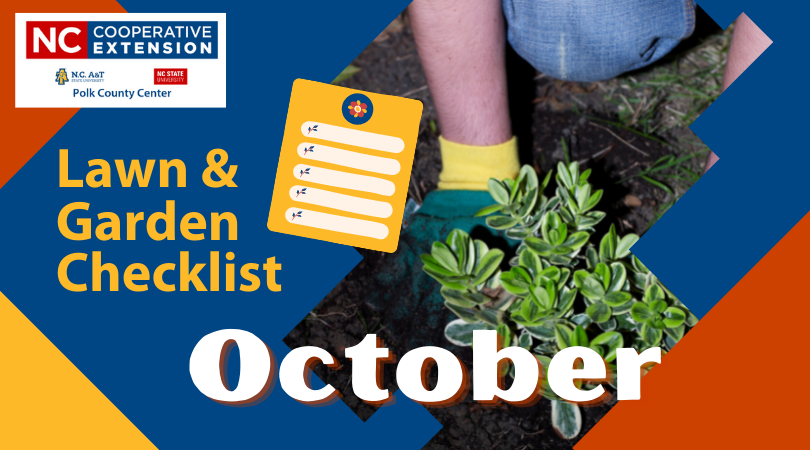Polk County Lawn & Garden Checklist for October
go.ncsu.edu/readext?824102
en Español / em Português
El inglés es el idioma de control de esta página. En la medida en que haya algún conflicto entre la traducción al inglés y la traducción, el inglés prevalece.
Al hacer clic en el enlace de traducción se activa un servicio de traducción gratuito para convertir la página al español. Al igual que con cualquier traducción por Internet, la conversión no es sensible al contexto y puede que no traduzca el texto en su significado original. NC State Extension no garantiza la exactitud del texto traducido. Por favor, tenga en cuenta que algunas aplicaciones y/o servicios pueden no funcionar como se espera cuando se traducen.
Português
Inglês é o idioma de controle desta página. Na medida que haja algum conflito entre o texto original em Inglês e a tradução, o Inglês prevalece.
Ao clicar no link de tradução, um serviço gratuito de tradução será ativado para converter a página para o Português. Como em qualquer tradução pela internet, a conversão não é sensivel ao contexto e pode não ocorrer a tradução para o significado orginal. O serviço de Extensão da Carolina do Norte (NC State Extension) não garante a exatidão do texto traduzido. Por favor, observe que algumas funções ou serviços podem não funcionar como esperado após a tradução.
English
English is the controlling language of this page. To the extent there is any conflict between the English text and the translation, English controls.
Clicking on the translation link activates a free translation service to convert the page to Spanish. As with any Internet translation, the conversion is not context-sensitive and may not translate the text to its original meaning. NC State Extension does not guarantee the accuracy of the translated text. Please note that some applications and/or services may not function as expected when translated.
Collapse ▲For more info, help, and advice on these or other lawn and garden topics, contact your Polk County Extension Director, Scott Welborn.
October is a good month to plant shrubs and trees (if it rains). At this time the soil is still warm enough to encourage root growth and will allow your plants to get established before the harsh cold of winter and will give them a boost for next spring. Be sure to water the plants thoroughly for several weeks after planting to ensure they do not dry out if rain is not plentiful. NOTE: If you are interested in planting herbaceous perennials, those are best planted in the spring.
It’s still not too late for some fall color. You can plant pansies now for a little fall/winter color and they will be established and give you a good show of color in the spring as well.
Bring houseplants indoors when temperatures dip below 50°F. Give them a good bath in soapy water or spray with insecticidal soap. Move plants into partial shade for a week to condition them to lower light levels indoors. Remember that indoor humidity is normally very low inside the house in the winter so be sure to mist your plant’s leaves with water along with watering their roots.
By this time in the garden you should have all your winter crops planted. These include root crops, cole crops and lettuces. These crops can provide you a harvest through most of the winter with very little cold protection. Fertilize these crops while it is still warm enough to achieve maximum growth. During fall warm dry periods, be sure to provide irrigation.
In areas not used for fall vegetable production make sure you plant a cover crop. Winter Rye (grain) or Annual Rye Grass are excellent choices for a cool-season cover crop. These plants are easy to grow and provide massive amounts of organic matter for your soil while preventing winter erosion. Leaving the soil bare should never be an option. Now is a good time for you to take a soil test in your garden. Soil testing is free until Thanksgiving. By knowing your pH and nutrient levels you can correct them so you have a better garden next year. It is critical to get your pH in the proper range so your plants can use the nutrients that are already in the soil. It can take 6-12 months for lime to take full effect so be sure to get it in the soil soon.
NOTE: The use of brand names in this publication does not imply endorsement by the North Carolina Cooperative Extension Service of the products or services named nor discrimination against similar products or services not mentioned.





